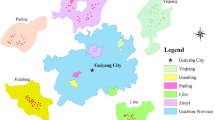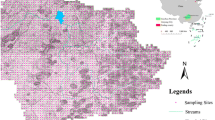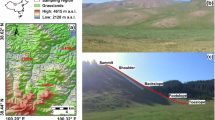Abstract
Purpose
So far, the soil organic carbon (SOC) literature is dominated by studies in the humid environments with huge stocks of vulnerable carbon. Limited attention has been given to dryland ecosystems despite being often considered to be highly sensitive to environmental change. Thus, there is insufficient research about the spatial patterns of SOC stocks and the interaction between soil depth, ecohydrology, geomorphic processes, and SOC stocks. This study aimed at identifying the relationship between surface characteristics, vegetation coverage, SOC, and SOC stocks in the arid northern Negev in Israel.
Materials and methods
The study site Sede Boker is ideally suited because of well-researched but variable ecohydrology. For this purpose, we sampled five slope sections with different ecohydrologic characteristics (e.g., soil and vegetation) and calculate SOC stocks. To identify controlling factors of SOC stocks on rocky desert slopes, we compared soil properties, vegetation coverage, SOC concentration, and stocks between the five ecohydrologic units.
Results and discussion
The results show that in Sede Boker, rocky desert slopes represent a significant SOC pool with a mean SOC stock of 0.58 kg C m−2 averaged over the entire study area. The spatial variability of the soil coverage represents a strong control on SOC stocks, which varies between zero in uncovered areas and 1.54 kg C m−2 on average in the soil-covered areas. Aspect-driven changes of solar radiation and thus of water availability are the dominant control of vegetation coverage and SOC stock in the study area.
Conclusions
The data indicate that dryland soils contain a significant amount of SOC. The SOC varies between the ecohydrologic units, which reflect (1) aspect-driven differences, (2) microscale topography, (3) soil formation, and (4) vegetation coverage, which are of greatest importance for estimating SOC stocks in drylands.






Similar content being viewed by others
References
Amundson R (2001) The carbon budget in soils. Ann Rev Earth Planet Sci 29:535–562
Ardö JLO (2003) Assessment of soil organic carbon in semi-arid Sudan using GIS and the CENTURY model. J Arid Environ 54:633–651
Arkin Y, Braun M (1965) Type sections of upper cretaceous formations in the northern Negev (southern Israel). Israel Geol. Survey Stratigraphic Section, No.2a, Jerusalem, pp 1–19
Arrouays D, Pelissier P (1994) Modeling carbon storage profiles in temperate forest humic loamy soils of France. Soil Sci 157:185–192
Asner GP, Borghi CE, Ojeda RA (2003) Desertification in Central Argentina: changes in ecosystem carbon and nitrogen from imaging spectroscopy. Ecol Appl 13:629–648
Balpande SS, Deshpande SB, Pal DK (1996) Factors and processes of soil degradation in Vertisols of the Purna Valley, Maharashtra, India. Land Degrad Dev 7:313–324
Berhe AA, Harden JW, Torn MS, Harte J (2008) Linking soil organic matter dynamics and erosion-induced terrestrial carbon sequestration at different landform positions. J Geophys Res 113:1–12
AG Bodenkunde (2005) Bodenkundliche Kartieranleitung KA 5 (German Soil Mapping Guide, 5th edition), Bundesanstalt für Geowissenschaften und Rohstoffe und Geologische Landesämter der Bundesrepublik Deutschland (Federal Institute for Geosciences and Natural Resources and Geological Survey offices of the Federal Republic of Germany) (eds.), Hannover, pp. 438
Bolton H, Smith JL, Link SO (1993) Soil microbial biomass and activity of a disturbed and undisturbed shrub-steppe ecosystem. Soil Biol Biochem 25:545–552
Branchu P, Faure H, Ambrost JP, Bakker EMV, Fauredenard L (1993) Africa as source and sink for atmospheric carbon dioxide. Glob Planet Chang 7:41–49
Bruins HJ (1986) Desert environment and agriculture in the Central Negev and Kadesh-Barnea during historical times. Ph.D. thesis, Agricultural University Wageningen. Midbur Foundation, Nijkerk, the Netherlands
Dan J, Yaalon DH, Koyumdjiski H, Raz Z (1972) The soil association map of Israel. Israel J Earth Sci 21:29–49
Danin A, Orshan G, Zohary M (1975) The vegetation of the northern Negev and the Judean Desert of Israel. Israel J Bot Basic Appl Plant Sci 24:118–172
Dotterweich M (2008) The history of soil erosion and fluvial deposits in small catchments of Central Europe: deciphering the long term interaction between human and the environment—a review. Geomorphology 101:192–208
Egli M, Sartori G, Mirabella A, Favilli F, Giaccai D, Delbos E (2009) Effect of north and south exposure on organic matter in high Alpine soils. Geoderma 149:124–136
Evenari M, Masig D, Rogel A (1980) Runoff-farming in the Negev Desert of Israel (VI). Jacob Blaustein Institute for Desert Research, Sede Boker
Fang C, Moncrieff JB (2001) The dependence of soil CO2 efflux on temperature. Soil Biol Biochem 33:155–165
FAO (ed) (2004) Carbon sequestration in dryland soil. World soil resources reports 102, Rome. Available at: http://www.fao.org/docrep/007/y5738e/y5738e00.htm. Accessed Febuary 2012
Farage P, Pretty J, Ball A (2003) Biophysical aspects of carbon sequestration in drylands. Seminar paper presented at University of Essex, Feb 3, 1–25 pp
Feng Q, Endo KN, Guodong C (2002) Soil carbon in desertified land in relation to site characteristics. Geoderma 106:21–43
Fliessbach A, Sarig S, Steinberger Y (1994) Effects of water pulses and climate conditions on microbial biomass kinetics and microbial activity in yermosol of Central Negev. Arid Soil Res Rehab 8:353–362
Glatzel S, Sommer M (2005) Colluvial soils and landscape position: field studies on greenhouse gas exchange and related ecological characteristics. Z Geomorphol 139:87–99
Glenn E, Squired V, Olson M, Frye R (1993) Potential for carbon sequestration in the drylands. Water Air Soil Pollut 70:341–355
Goidts E, van Wesemael B (2007) Regional assessment of soil organic carbon changes under agriculture in Southern Belgium (1955–2005). Geoderma 141:341–354
Grieve IC (2001) Human impacts on soil properties and their implications for the sensitivity of soil systems in Scotland. Catena 42:361–374
Griffiths RP, Madritch MD, Swanson AK (2009) The effects of topography on forest soil characteristics in the Oregon Cascade Mountains (USA): implications for the effects of climate change on soil properties. For Ecol Manag 257:1–7
Hoffmann T, Glatzel S, Dikau R (2009) A carbon storage perspective on alluvial sediment storage in the Rhine catchment. Geomorphology 108:127–137
Houghton RA (2007) Balancing the global carbon budget. Ann Rev Earth Planet Sci 35:313–347
IPCC (2007) Chapter 7: Couplings between changes in the climate system and biogeochemistry. In: Climate Change 2007: The physical science basis. Contribution of Working Group I to the Fourth Assessment Report of the Intergovernmental Panel on Climate Change. Cambridge University Press, Cambridge
IUSS Working Group WRB (2006) World reference base for soil resources 2006. World soil resources reports no. 103. FAO, Rome
Jobbágy EG, Jackson RB (2000) The vertical distribution of soil organic carbon and its relation to climate and vegetation. Ecol Appl 10:423–436
Kirschbaum MUF (2000) Will changes in soil organic carbon act as a positive or negative feedback on global warming? Biogeochemistry 48:21–51
Kuhn NJ, Yair A (2004) Spatial distribution of surface conditions and runoff generation in small arid watersheds, Zin Valley Badlands, Israel. Geomorphology 57:183–200
Kuhn NJ, Hoffmann T, Schwanghart W, Dotterweich M (2009) Agricultural soil erosion and global carbon cycle: controversy over? Earth Surf Proc Land 34:1033–1038
Laity J (2008) Deserts and desert environments. Wiley-Blackwell, Singapore, p 342
Lal R (2003) Carbon sequestration in dryland ecosystems. Environ Manage 33:528–544
Lal R (2005) Soil erosion and carbon dynamics. Soil Tillage Res 81:137–142
Lal R (2009) Sequestering carbon in soils of arid ecosystems. Land Degrad Dev 20:441–454
Lal R, Kimble JM, Stewart BA (2001) Importance of soil bulk density and methods of its measurement. In: Kimble JM, Follett RF, Stewart BA (eds) Assessment methods for soil carbon. CRC Press, Boca Raton, pp 31–44
Leifeld J, Bassin S, Fuhrer J (2005) Carbon stocks in Swiss agricultural soils predicted by land-use, soil characteristics, and altitude. Agr Ecosyst Environ 105:255–266
Li P, Wang Q, Endo T, Zhao X, Kakubari Y (2010) Soil organic carbon stock is closely related to aboveground vegetation properties in cold-temperate mountainous forests. Geoderma 154:407–441
McAuliffe JR (1990) A rapid survey method for the estimation of denisty and cover in desert plant communities. J Veg Sci 1:653–656
Michaelides K, Chappell A (2009) Connectivity as a concept for characterising hydrological behaviour. Hydrol Process 23:517–522
Mishra U, Lal R, Slater BK, Calhoun F, Liu D, Van Meirvenne M (2009) Predicting soil organic carbon stock using profile depth distribution functions and ordinary kriging. Soil Sci Soc Am J 73:614–621
Olsvig-Whittaker L, Shachak M, Yair A (1983) Vegetation patterns related to environmental factors in a Negev Desert watershed. Vegetation 54:153–165
Parsons AJ, Abrahams AD (eds) (2009) Geomorphology of desert environments, 2nd edn. Springer, New York
Perkins JS, Thomas DSG (1993) Spreading deserts or spatially confined environments? Land degradation and cattle ranching in the Kalahari Desert of Botswana. Land Degrad Rehabil 4:179–194
Qi Y, Xu M, Wu J (2002) Temperature sensitivity of soil respiration and its effects on ecosystem carbon budget: nonlinearity begets surprises. Ecol Model 153:131–142
Quinton JN, Govers G, Van Oost K, Bardgett RD (2010) The impact of agricultural soil erosion on biogeochemical cycling. Nat Geosci 3:311–314
Ravindranath NH, Ostwald M (2008) Carbon inventory methods. Handbook for greenhouse gas inventory, carbon mitigation and roundwood production projects. Advances in global change research 29. Springer Science + Business Media B.V, Dordrecht, 308 pp
Reifenberg A (1947) The soils of Palestine. Murby, London, p 106
Rodeghiero M, Heinemeyer A, Schrumpf M, Bellamy P (2009) Determination of soil carbon stocks and changes. In: Kutsch WLB, Heinemeyer A (eds) Soil carbon dynamics. An integrated methodology. Cambridge University Press, New York, pp 49–75
Rosenbloom NA, Harden JW, Neff JC, Schimel DS (2006) Geomorphic control of landscape carbon accumulation. J Geophys Res 111:1–10
Rotenberg E, Yakir D (2010) Contribution of semi-arid forests to the climate system. Science 327:451
Sarmiento JL, Gruber N (2002) Sinks for anthropogenic carbon. American Institute of Physics
Schimel DS (2010) Drylands in the earth system. Science 327(5964):418–419
Schimel D, Enting IG, Heimann M, Wigley TML, Raynaud D, Alves D, Siegenthaler U (1994) CO2 and the carbon cycle. Extracted from the Intergovernmental Panel on Climate Change (IPCC Report, “Climate Change, 1994”). In: Wigley TMLS (ed) The carbon cycle. Cambridge University Press, New York, pp 7–36
Schimel D, Melillo J, Tian H (2000) Contribution of increasing CO2 and climate to carbon storage by ecosystems in the United States. Science 287:2004–2006
Schlesinger WH (1977) Carbon balance in terrestrial detritus. Annu Rev Ecol Syst 8:51–81
Schlesinger WH (1990) Evidence from chronosequence studies for a low carbon-storage potential of soils. Nature 348:232–234
Schlesinger WH (1991) Biogeochemistry: an analysis of global change. Academic, San Diego, p 588
Schlesinger WH, Pilmanis AM (1998) Plant–soil interactions in deserts. Biogeochemistry 42:169–187
Schlesinger WH, Raikes JA, Hartley AE, Cross AF (1996) On the spatial pattern of soil nutrients in desert. Ecosyst Ecol 77:364–374
Schreiber KF, Yair A, Shachak M (1995) Ecological gradients along slopes of the Northern Negev Highlands, Israel. Catena Adv Geoecol 28:209–229
Seip HM (2001) We know too little about the carbon cycle. Cicerone (1), Oslo, p 6
Smith JE, Heath LS (2002) A model of forest floor carbon mass for United States forest types. Newtown Square, PA: U.S. Department of Agriculture, Forest Service, Northeastern Research Station, Newtown Square PA. Research Paper NE-722, 37 pp
Tan ZX, Lal R, Smeck NE, Calhoun FG (2004) Relationships between surface organic carbon pool and site variables. Geoderma 121:187–195
Tsui C-C, Chen Z-S, Hsieh C-F (2004) Relationships between soil properties and slope position in a lowland rain forest of southern Taiwan. Geoderma 123:131–142
van Wesemael B, Paustian K, Meersmans J, Goidts E, Barancikova G, Easter M (2010) Agricultural management explains historic changes in regional soil carbon stocks. Proc Natl Acad Sci 107:14926–14930
Wang S, Huang M, Shao X, Mickler RA, Li K, Ji J (2004) Vertical distribution of soil organic carbon in China. Environ Manage 33:200–209
Watson RT, Noble IR, Bolin B, Ravindranath NH, Verardo DJ, Dokken DJ (eds) (2000) Land use, land-use change, and forestry. A special report of the IPCC. Cambridge University Press, Cambridge
Wigley TML, Schimel DF (eds) (2005) The carbon cycle. Cambridge University Press, Cambridge. 312 pp
Yaalon DH, Dan J (1974) Accumulation and distribution of loess-derived deposits in the semi-desert and desert fringe areas of Israel. Z Geomorphol 20:91–105
Yair A (1990) The role of topography and surface cover upon soil formation along hillslopes in arid climates. Geomorphology 3:287–299
Yair A (1992) The control of headwater area on channel runoff in a small arid watershed. In: Parsons AJ, Abrahams AD (eds) Overland flow: hydraulics and erosion mechanics. UCL Press, London, pp 53–68
Yair A (1994) The ambiguous impact of climate change at a desert fringe: Northern Negev, Israel, A.C. In: Millington AC, Pye K (eds) Environmental change in drylands: biogeographical and geomorphological perspectives. Wiley, Chichester, pp 199–227
Yair A, Danin A (1980) Spatial variations in vegetation as related to the soil moisture regime over an arid limestone hillside, Northern Negev Israel. Oecologia 47:83–88
Yair A, Raz-Yassif N (2004) Hydrological processes in a small arid catchment: scale effects of rainfall and slope length. Geomorpholohgy 61:155–169
Yair A, Shachak M (1982) A case study of energy water and soil flow chains in an arid ecosystem. Oecologia 54:389–397
Yao S-H, Zhang B, Hu F (2010) Biophysical controls over mineralization and sequestration of amended organic carbon in soil: effects of intensity and frequency of drying and wetting cycles. World Congress of Soil Science: Soil solutions for a changing world. Brisbane, Australia
Yoo K, Amundson R, Heimsath AM, Dietrich WE (2006) Spatial patterns of soil organic carbon on hillslopes: integrating geomorphic processes and the biological C cycle. Geoderma 130:47–65
Zaady E, Groffman P, Shachak M (1996) Litter as a regulator of N and C dynamics in macrophytic patches in Negev Desert soils. Soil Biol Biochem 28:39–46
Zak JC, Willig MR, Moorhead DL, Wildman HG (1994) Functional diversity of microbial communities: a quantitative approach. Soil Biol Biochem 26:1101–1108
Zhou ZY, Li FR, Chen SK, Zhang HR, Li G (2011) Dynamics of vegetation and soil carbon and nitrogen accumulation over 26 years under controlled grazing in a desert shrubland. Plant Soil 341:257–268
Zohary M (1962) Plant life in Palestine, Israel and Jordan. The Roland Press Co., New York, p 262
Acknowledgments
We owe our gratitude to the Freiwillige Akademische Gesellschaft (FAG) Basel and the University of Basel for funding the field work in Sede Boker.
Author information
Authors and Affiliations
Corresponding author
Additional information
Responsible editor: Zucong Cai
Rights and permissions
About this article
Cite this article
Hoffmann, U., Yair, A., Hikel, H. et al. Soil organic carbon in the rocky desert of northern Negev (Israel). J Soils Sediments 12, 811–825 (2012). https://doi.org/10.1007/s11368-012-0499-8
Received:
Accepted:
Published:
Issue Date:
DOI: https://doi.org/10.1007/s11368-012-0499-8




